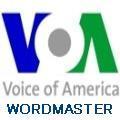How a Handshake Can Say a Lot About You in Business Communication
AA: I'm Avi Arditti, Rosanne Skirble is away. This week on WORDMASTER, English teacher Nina Weinstein joins me from Los Angeles to discuss business communication in America, including body language -- like the importance of a firm handshake. Business people from Japan, for example, are used to bowing, not shaking hands the way Americans do.
NINA WEINSTEIN: "The firmness of the handshake transmits information. It says that 'I am strong, I am confident and I'm happy to meet you.' Some people want to shake for a long time and really the average handshake is three shakes. So -- " AA: "Just kind of like one, two, three; reach forward, shake hands three times and ... " NINA WEINSTEIN: "Exactly. One of the other things we talk about is the issue of men and women in business. Some of my students, actually a lot of my students have learned that you don't shake hands with a woman unless she offers her hand first. And this is a very, very old fashioned rule. What I tell my students is that you shake hands with everyone the same way. And it doesn't matter if she's a woman or a man, doesn't matter." AA: "And what do you say when you're shaking hands?" NINA WEINSTEIN: "We extend our hands and as we're shaking we say 'nice to meet you.' And there's a kind of rhythm to that that we take for granted, but that is not natural to the students. So I give them a one-two-three: my name first, extending my hand is number two and number three [is saying] 'nice to meet you' as we're shaking hands. And then they can give more information about their background." AA: "So now moving into the business English part of this here, so you need to make a smooth transition -- right? -- from shaking hands, introducing yourselves. What comes next?" NINA WEINSTEIN: " Next could be small talk or it could be what we call making people comfortable. So if you're meeting someone in your own office or in your own environment, you might offer them coffee or tea. You might say 'Please have a seat.' You might begin with a little bit of small talk.
"So those things come right after the introduction. And with regard to small talk, that's another lesson, another kind of long lesson. We don't want to get to the business right away. As soon as someone comes into a room, we don't say 'I've called you here because, blah blah blah.' We need to relax." AA: "And small talk can be pretty difficult to actually, if you're not comfortable with it -- even native speakers aren't always comfortable with small talk. Do you have any advice or tips that you give people?" NINA WEINSTEIN: "I give them some topics that are good in any situation. For instance, if it's Monday, we can always say 'Did you have a nice weekend?' If it's Thursday or Friday we can always say 'What are your plans for the weekend?' So we can talk about weekend or vacation plans with just about anybody. We can always talk about the weather. The topics that are not good would be anything emotional." AA: "So now we've talked about how to begin a conversation with handshake and greeting and so forth, what about ending a conversation? What do you tell your students?" NINA WEINSTEIN: "If they have just met the person, then at the end of the conversation they should say 'It was really nice meeting you.' And then if the other person has said that first, then their response would be 'It was really nice meeting you, too.' If it wasn't an introduction, if they just spoke, then 'It was very nice talking to you.' Or the verb will be whatever describes what they were doing: 'It was very nice meeting with you,' 'It was very nice having dinner with you.'" AA: "And shake hands again." NINA WEINSTEIN: "And shake hands again. The handshake is used a lot. We also discuss different variations of the handshake. Sometimes when you're shaking hands, the person will put their other hand on top of your hand, and this is a kind of affection and it shows friendship and so forth. So we have to be aware that that's what that is. "And also, people hug here a lot more than they may in other cultures. My students can be very uncomfortable with that because it's just not something that they're used to. So they may go to a business party and hug someone that they've never actually hugged before -- not that they initiated it, the other person did. And so I always tell them to just make it brief if they feel uncomfortable -- you shouldn't do anything that you're uncomfortable with -- and kind of create as much distance as they can without making the person feel that they're carrying bacteria or a virus or something." AA "Just kind of give a little hug back." NINA WEINSTEIN: "Yeah, and then that's it." AA: Nina Weinstein has taught business English for about thirty years and has written books on this subject and others. You can find her previous WORDMASTER segments and also learn more about the art of small talk at our Web site, voanews.com/wordmaster.
And that's all for this week. Our e-mail address is word@voanews.com. I'm Avi Arditti.

